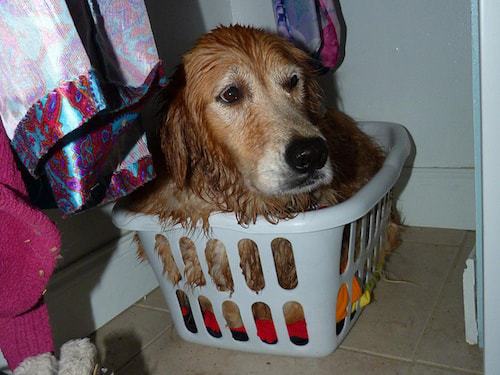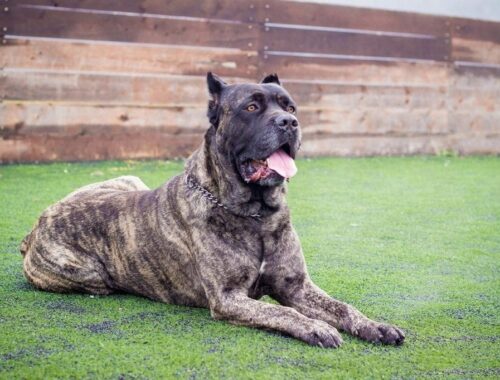My mom used to have a greyhound named Earl, whom we called “Earl-o-Meter 2000.” He would hide under furniture and tremble from head to toe. It happened regularly and was a bit concerning at first. Have you ever wondered, “What does it mean when my dog gets the shakes?”
We figured out that Earl was terrified of thunderstorms. He could sense the changing barometric pressure before the first raindrop fell. He was more reliable than the TV weatherman in predicting a thunderstorm, hence the nickname.
Dogs get the shakes, shivers, and tremble for a variety of reasons. Some of the causes are pretty tame, and others can indicate a serious problem. If your dog has the shakes, it’s time to do some investigation.

Top 8 Causes of Shivering in Dogs
- Cold. Even if your dog feels warm to the touch, he may be chilly. Shaking to warm up is a normal response. Covering him with his own blanket might do the trick.
- Anxiety. Dogs often shake or shiver when they are afraid or nervous. He may also try to hide behind you or get away from the thing that’s scaring him. Try using a “calming vest” during stressful events. Calming collars and diffusers can also help.
- Excitement. Like anxiety, excitement can lead to trembling. Observe the dog’s body language. Pulling on the leash, barking, jumping around behavior will let you know your dog is excited, not anxious.
- Dreaming. When dogs sleep, they go through periods of dreaming. It’s not abnormal for a dog to shake, move her legs, and vocalize while sleeping.
- Pain. Acute pain from an injury or even a slipped disc in the back can cause shaking. You may or may not be able to localize the pain.
- Nausea. This one’s not too hard to imagine. Nausea can be overwhelming and scary to a dog. A nauseous dog may refuse food, drool, and pant in addition to shivering.
- Fever. Fevers can cause shaking. Fevers often cause other symptoms like poor appetite and lethargy that may tip you off to this cause of shaking. You can check your dog’s temperature rectally with a digital thermometer. If it’s over 102.9, that’s considered a fever.
- Geriatric muscle tremors. No one knows why, but older dogs sometimes develop tremors that affect their rear legs. It’s most noticeable while they are standing. These tremors rarely cause any problems and don’t progress to anything more serious.
Less Common Causes of Shaking in Dogs
- Pyrethrin toxicosis. Exposure to products like anti-flea drops, dips, and sprays can cause full body shaking when overdosed or in sensitive animals.
- Snail poison. The chemical metaldehyde can cause shaking, twitching, and seizures.
- Rat poisons. Bromethalin has an effect on the central nervous system, leading to seizures.
- Tremorgenic molds. Certain molds found on rotting foods can lead to tremors and seizures when eaten by dogs.
- Sodium overdose. Eating way too much salt leads to electrolyte imbalances and can cause seizures. Ingestion of paintballs, high sugar content products, and other dry products that cause large fluid shifts in the intestines lead to a relative sodium overdose.
- Serotonergic drugs (SSRIs, TCA’s, MAOIs, etc.). Overdose or use in sensitive animals may cause tremors and seizures.
- Amphetamines and caffeine. These drugs can cause shaking and seizures in dogs, just like they do in humans.
- Neurological disease. Inflammation in the central nervous system can lead to shaking and seizures in affected dogs.
- Low blood calcium. Hypocalcemia is most common in small breed dogs who are new mothers and nursing puppies. It can also happen as part of certain endocrine diseases and cancers.
- Low blood sugar (hypoglycemia). Hypoglycemia can cause full body tremors or even a seizure. Low blood sugar can be caused by overwhelming infection, starvation, and insulin overdose in diabetics.
- Epilepsy/seizure. The classic seizure involves the entire body and the dog is mentally unaware of his surroundings. Dogs can also have partial seizures in which they seem alert but some part of their body may be shaking or otherwise abnormal.

What to Do When Your Dog Gets the Shakes
Check to see if he is cold. He may not feel cold to the touch but maybe shaking to warm himself up. Try covering him with a blanket to see if that helps.
Check for other unusual symptoms:
- Poor appetite, change in drinking, bowel movements or urination
- Limping
- Low energy level
- Crying out in pain or having trouble getting comfortable while resting
- Drooling, vomiting, belching
- Coughing
- Abnormal mental state
Check if your dog has ingested something toxic. Look around to see if he has gotten into the trash, cleaning supplies, chemicals, insecticides, medications, or anything else unusual. If you find something either take the container to the vet’s office or write down the information from the label to share with the veterinarian.
If your dog is showing symptoms other than shaking he should be seen by a veterinarian right away. This is especially true if he seems mentally abnormal, has trouble walking, or difficulty breathing. Your veterinarian will ask you a lot of questions, so be prepared by thinking through all the possibilities discussed here.
Featured Image Credit: SikorskiFotografie, Shutterstock
Photo credits:
“Jinx” cc by 2.0 by Will Keightley
“Thunderstorm” cc by 2.0 by Rusty Clark~100K Photos
































